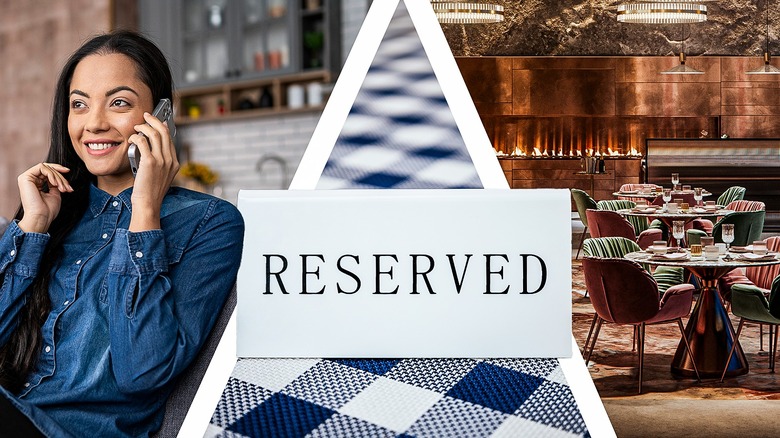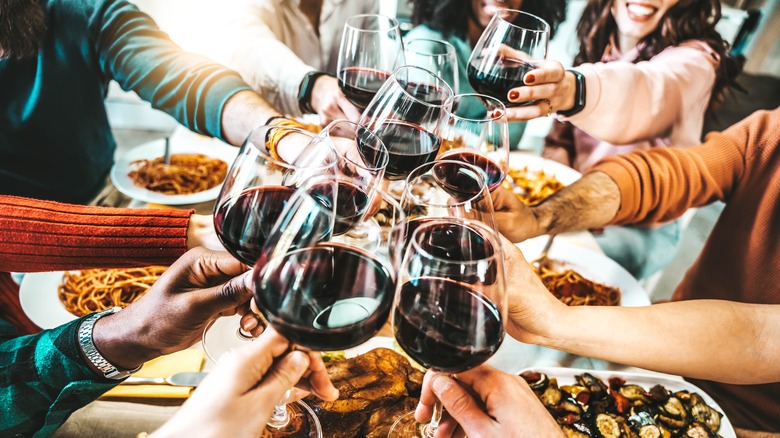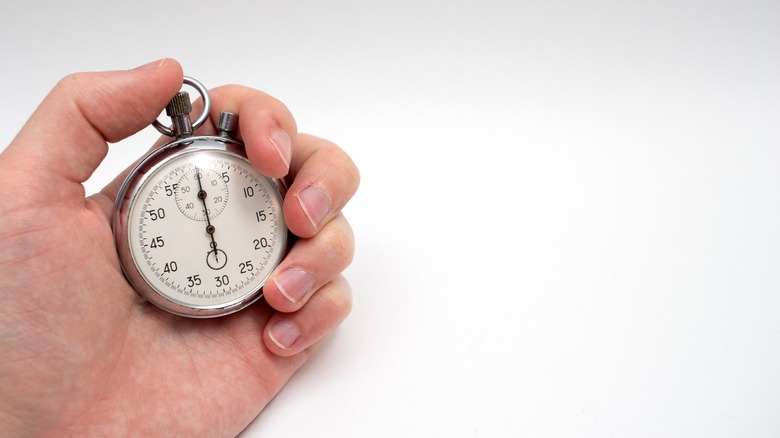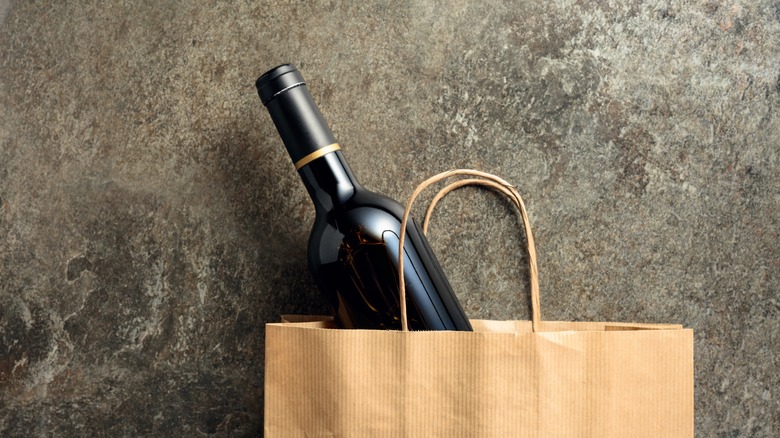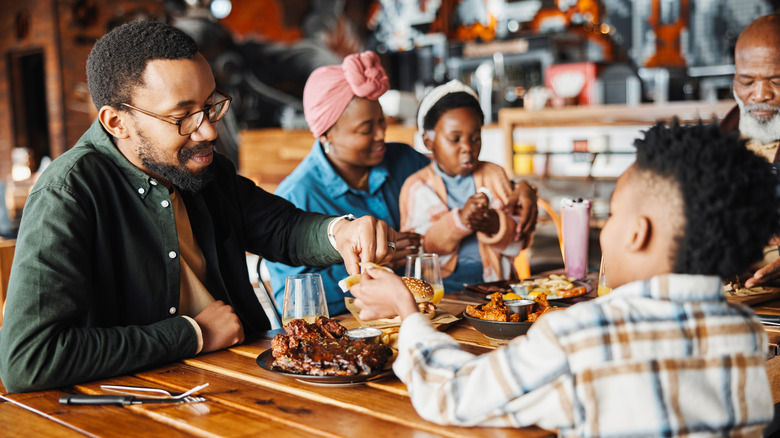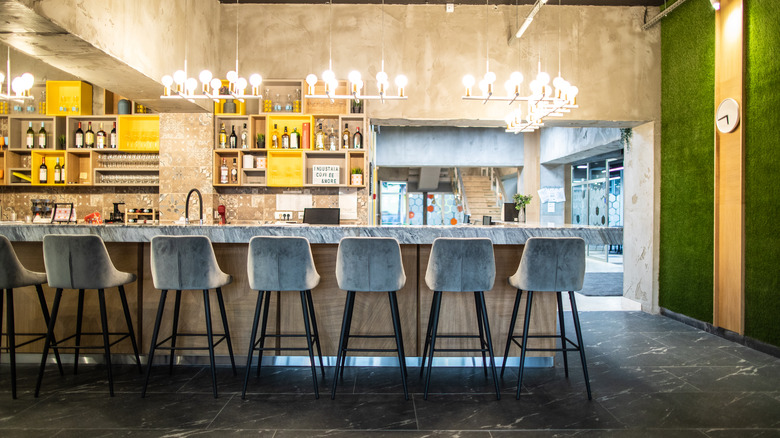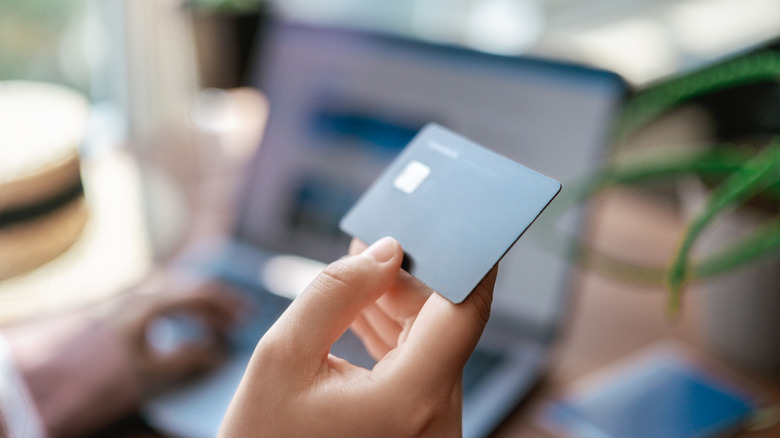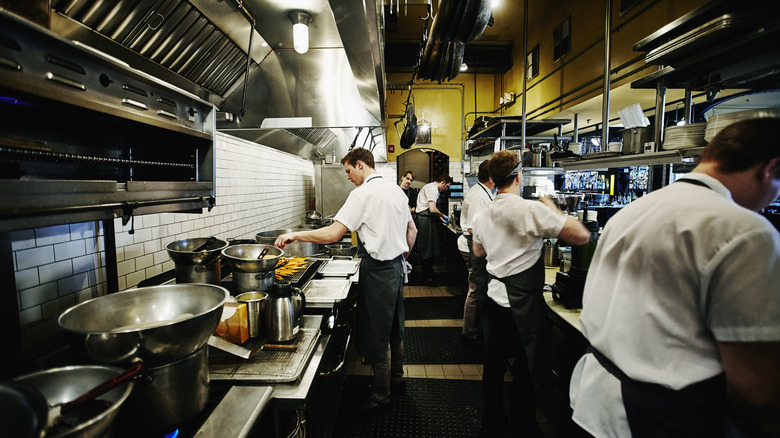11 Important Things An Expert Does When Making A Restaurant Reservation
Whether you're heading to the newest hot spot or your favorite local dinner location, a restaurant reservation always comes in handy. Booking a table means there's a spot saved for you, avoiding potentially long wait times or the chance that there isn't a seat to be had. Making a reservation has come a long way in recent years, with apps and websites (and even AI assistants) turning this chore into a breeze. But all that convenience doesn't mean the etiquette and expectations that go along with a restaurant reservation have gone out the window. Just as diners expect restaurants to hold tables, be well-staffed, and have delicious menu options at the ready, restaurants expect their customers to follow some important reservation guidelines.
During my time as a restaurant owner, the dining room was my domain. I managed our reservation system, worked the host stand, and was the point of contact for guests for everything from booking a table to planning a special event. This list combines a little common sense, some reservation best practices, and things every restaurant wishes you would do when you make a reservation to ensure your meal (and its night!) goes smoothly.
1. Make the right reservation for your party size
Have you ever noticed that some restaurants list a maximum party size for online booking? It's usually six or eight guests, requiring larger parties to call and book their table over the phone. There's a reason for that. Dining rooms are arranged with specific table sizes and groupings to maximize the number of guests that can be served in a night. This helps a restaurant manage how many guests arrive and are seated at a given time, which helps maintain a more even flow for the kitchen. Even pacing means your food arrives in a timely manner, hot (or cold) and fresh.
If you're dining with a party that is big enough that the restaurant asks you to call, please call! Most restaurants are more than willing to accommodate your party — it just means they'll need to adjust what other types of reservations they accept for the night. Some might also require a deposit, a food and beverage minimum, or even a set menu for the most efficient experience and the best level of service.
Something you should never do? Make two separate reservations and assume the restaurant can push your tables together. The dining room layout, other reservations, and even things like ADA code might prevent this from being possible. Plus, it's a surefire way to drive the host crazy and make the staff less likely to go above and beyond for you and your group.
2. Know how long the reservation is for
You've carefully selected when you want your reservation to start, but you should also be aware of when it will end. This is just as important for the restaurant's bottom line as it is for other guests, so please be considerate.
Turn times (how much time guests spend at a given table) are critical to the operation of a restaurant every night. By knowing how long a table will be occupied, the restaurant team can manage how many orders go to the kitchen at one time, how many groups can be seated at the table each night, and, as a result, approximately how much money it can plan to make. This also impacts things like staffing and product ordering and waste. Way more than just how long you have to finish your last few sips of wine, right?
Whether it is 90 minutes, two hours, or longer, understanding how much time you and your party can spend at the table also affects any diners who arrive after you. If you have a 5:30 p.m. reservation and are done by 7:30, the restaurant can clean and reset the table for its 7:30 p.m. reservation without asking them to wait. On the other hand, if you linger over dessert and aren't done until 8:00, that 7:30 reservation either has to wait or has to be seated elsewhere — causing a domino effect throughout the reservation book.
3. Double check BYOB policies
I can't tell you how many times guests asked if they could bring their own wine to dinner — and even offered to pay me to serve it to them. Would my staff have loved the extra cash? Sure. But in Colorado, where my restaurant was, BYOB restaurants are against the law, as is serving alcohol that wasn't purchased from a licensed distributor. I would have loved to let guests celebrate a milestone occasion with a special bottle of wine from their cellar, but I would have been risking my liquor license to do so — and that is the case in many other states and municipalities, too.
Before you pack a bottle to bring with you to a restaurant, do a quick search on local BYOB policies. Don't forget to also check directly with the restaurant, because even if it's allowed in your area, that doesn't mean the restaurant allows guests to bring drinks into its dining room.
Some restaurants that allow guests to bring their own alcohol will have restrictions on the types of alcohol allowed or may charge a corkage or service fee. Why? If a restaurant sells its own booze and you're not buying it from there, the restaurant is losing money! Plus, its staff is opening and serving your wine, and washing the dishes, so that fee goes to cover labor that would otherwise be paid for by an alcohol purchase.
4. Confirm the birthday cake policy
Before you start baking, check the restaurant's policy on birthday cakes. Some restaurants may not allow it at all, instead requesting that you order dessert from the menu. It is, after all, why you're there! If the restaurant does allow you to bring your own dessert, consider this: Can you bring a homemade cake, or does it have to come from a professional kitchen? Will the restaurant have space to store your dessert? And, most importantly, does it charge a fee for slicing and serving?
While regulations vary widely, the rules from my local health department forbade us from serving homemade food in our restaurant. All food had to come from a commercial kitchen, be it the local grocery store or a boutique bakery. Storage space in a restaurant walk-in is also at a premium. Before you show up with a cake that needs to be chilled until it is served, call to see if the restaurant can accommodate you. We were usually able to carve out some space for a few hours, but the heads-up meant we didn't have to scramble to make room during service.
The restaurant may charge a cake cutting fee. This cost covers labor (your server, bussers, and dishwashers) who still have to work to set your table, provide clean plates and forks, serve the cake, and clear the plates when you're done. It also helps offset revenue lost because you aren't ordering dessert from the menu.
5. Ensure every guest is included in the reservation — including kids
You would be amazed how many times groups showed up at our restaurant with more people than they'd reserved for because "the kids don't need much space." No matter your child's age or size, include every single person in your party in your reservation.
Why is this a big deal? Those extra kids require extra space. If the restaurant is booked solid, there might not be a spare table to push over or chairs to pull up. Speaking of chairs, do your kids really want to share a chair or sit in your lap all night? Plus, they're going to eat! The correct number of guests on a reservation helps the kitchen know what to expect throughout the night. Also include any infants in car seats or strollers in your reservation. Yes, only two adults are eating, but that giant stroller won't fit next to a table for two. You, your server, and the guests around you will be much more comfortable if you're seated as a group of three (i.e. at a bigger table).
Call the restaurant or make a note on your reservation to let it know that third person won't be eating, and to give the staff the opportunity to seat you at a table that will be most comfortable for everyone. This is especially important if the restaurant is small. Every inch between tables is accounted for, and some of the spaces are even regulated by ADA standards and local fire codes.
6. Reserve the right kind of table
Reservation systems are pretty sophisticated. Restaurants can specify whether tables are inside or outside, high-top tables or bar seating, or large communal tables shared between parties. This is great news for diners, because you can pick the type of table you want (and the one you'd be most comfortable at) and can be confident your selection will be available when you arrive. Your job? Read the description!
Understand whether a bar reservation is at the actual bar or at an adjacent high-top table, as well as what the policy is in case of inclement weather on the patio. It always throws the host for a loop when a guest with limited mobility has reserved a high-top table that requires sitting on bar stools, leaving the host scrambling to find a more suitable option in a busy dining room. Don't see what you want? Book a table you'd be comfortable with, then give the restaurant a call to let it know what you'd prefer. The host can make a note to move you to the patio if something opens up or can keep an eye out for cancellations in the dining room.
In the event of inclement weather, we would always do our best to move guests inside — often opting not to seat walk-ins so we could accommodate our reservations — but it sometimes also required changing peoples' reservation times. If you're flexible, let the restaurant know early so it can find you the best table, as well as have more options available for other guests through the evening.
7. Review the deposit and cancellation policies
Guests are quick to complain about reservation deposits and cancellation fees, but for a restaurant, this fee is a security deposit. In an industry where every table, every guest, and every dish counts, reservation deposits are an effort to avoid no-shows — something that can cost a restaurant, big time.
Yes, reservations are an amazing tool for a restaurant. Knowing how many guests to expect impacts the number of staff scheduled for the evening, how much food is ordered and prepped, and if there are other last-minute changes management needs to make before the doors open. But if a guest makes a reservation and then doesn't show up (and doesn't cancel first), the restaurant is left holding a table for a group that will never arrive, turning away walk-in customers and, by extension, turning away profit.
Before you complain, keep in mind that the fee is applied to your final bill, or may not be charged at all unless you don't show up. It isn't a separate cost for the privilege of dining at the restaurant so much as it is assurance for the restaurant that you will, in fact, arrive. This doesn't mean that you can't cancel under any circumstances, but that you should make sure you know what those circumstances are. Note how far in advance you need to cancel in order to avoid any fees, as well as any no-show fees — a cost you definitely want to avoid.
8. Communicate if you're running late for your reservation
We've all been there: The dinner reservation is in 20 minutes and traffic is terrible, you can't find a parking spot, or your daughter can't find her favorite shoes. Life happens, and we're all human.
As a restaurant owner, we would hold tables for guests for 20 minutes beyond their reservation time. We stated this policy on our website, as we wanted to be understanding of our guests while also acknowledging that a restaurant is a for-profit business. Many restaurants include similar language on their booking page, so take a peek — especially if being a little bit late is part of your lifestyle.
Even with that built-in buffer, it's just good manners (and maybe good karma) to call and let the restaurant know you're running behind. A host is more likely to actively hold your table if they know you're on your way versus if they're concerned you're ghosting them. Expecting a major delay? Giving the restaurant a heads-up will also give it the chance to adjust your reservation time to accommodate other guests. That might mean sitting for dinner 30 minutes later than you'd planned, but on the bright side, you've still got a table with your name on it.
9. Confirm if the restaurant can accommodate your dietary restrictions
Restaurants are in the customer service business. That means everyone from the host to your server to the kitchen staff are doing their best to make you happy and to ensure you enjoy your experience. This is especially true when it comes to allergies and dietary restrictions — two things that can make a dinner out go south in a hurry.
While the staff is there to take care of you, it is on you (as the person with a dietary restriction) to communicate your needs up front and to confirm whether the restaurant can accommodate you. Nut allergies, lactose intolerance, gluten sensitivities, and vegetarian or vegan diets are commonplace, and most restaurants will have a plan in place to address any of these specific needs. So, when your server asks if there are any allergies or restrictions in your group before you order, speak up! They are your best resource for menu guidance.
However, it's important to recognize that a restaurant cannot anticipate every single dietary need. I once had a guest lecture me about the sugar we used in our desserts (mostly white cane sugar). This guest had a health condition that required foods with a lower glycemic index, and they couldn't believe we didn't have desserts made with specialized sugar alternatives. Did we want to accommodate everyone? Absolutely. But since our desserts were made in batches in advance, there was no way to remove the white sugar from our pot de crème or brownies.
10. Call to see if there are any other reservations available
Let me be clear: I do not condone calling a restaurant to try to convince it to reserve a table for you when its books are full. However, there are reasons an online reservation system doesn't include every single available table, and politely calling to check is okay in my book. Most restaurants will have some tables that aren't available online. They might be set aside for walk-in guests, reserved for old-school (or older) customers who prefer to book over the phone, or even kept off of the reservation system if online booking charges the restaurant a fee for each table booked. OpenTable, for example, charges a fee of $1.00 to $1.50 per cover booked on its website or app, which means a table of four incurs a fee of $4.00 to $6.00, depending on a restaurant's subscription plan.
Especially if you're polite and friendly — and maybe also a regular — the host might be able to work some magic for you and squeeze you in for a reservation. But please keep your expectations in check. Sometimes, fully booked just means fully booked, so be ready to get on a waitlist or try your luck at walking in for dinner instead.
11. Check what time the kitchen closes
Night owls, rejoice. While everyone else is eating dinner between 6 p.m. and 7 p.m., you can bide your time, arriving at the restaurant for the final seating to enjoy a more relaxed atmosphere and less pressure to get up so the next party can be seated. Later reservations tend to be more plentiful, so if you're happy eating at 8:30, you're probably in luck.
The downside to eating later? You won't have to hurry to give up your table, but you'll need to be mindful of when the bar and kitchen close. With a two-hour turn time, you can expect your 8:30 p.m. reservation to wrap up at 10:30, but that doesn't mean you'll have food coming to the table at 10:25. Each restaurant will have its own parameters for when the kitchen closes, but in general, food production will wind down once the last group of diners has received their entrées. End-of-the-night diners should plan to order appetizers and entrées all at once, allowing the kitchen to pace the meal and have things ready in a timely manner.
If you want to eat late, the latest available reservation will still be within the restaurant's operating hours and will be a time the staff is comfortable with. Planning to walk in and grab a bite at the bar? Make a quick call and confirm the kitchen is still open before you head over.
